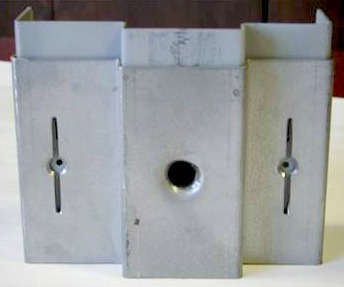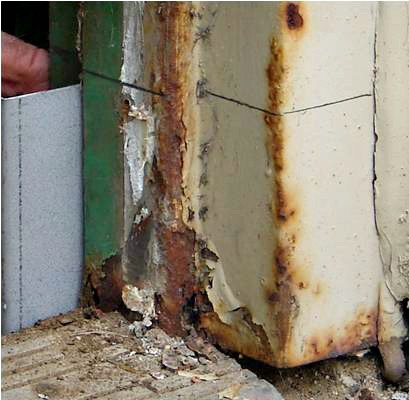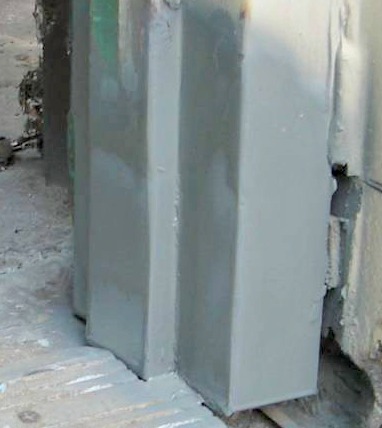|
Commercial Steel Entry Door Jamb Repair Buy Now!
Steel entry doors and frames can and do provide years of reliable service but in many of these systems the bottom of the frames eventually rust or corrode. The corrosion of a steel door-frame results in a number of undesirable conditions. It provides a path for rodents, it allows contaminants and debris into the facility, it is a path for energy loss and, in the worst-case scenario, and it can lead to a structural weakening of the door system. In the most severe cases, complete removal of the existing frame & door and installation of a new frame & door becomes necessary.
Replacement of a frame and door is expensive. Typically requiring an experienced door technician a full day to complete this repair (assuming no complications from the removal and install), cost for this repair can easily exceed $1,000.00. The majority of this cost is the labor required to remove the frame, yet in many instances only the rusted portion of the frame actually requires repair.
The Jamb Patch (Patent Pending) is designed to significantly reduce the time and labor required to repair a rusted entry door frame. It is manufactured from corrosion resistant steels to help extend the life of the door-frame and designed for “do-it-yourself” installation, further lowering the cost of the repair.
 |
Figure 1
Jamb Patch with bondo back-up sleeve extended. |
Causes of Corrosion
Moisture in contact with the frame or jambs eventually causes rusting of the jambs, most often starting and first seen in the lower ends of the jambs. Most people think the corrosion is the frame rusting from the outside towards the inside. In fact, exactly the opposite is true; the steel jambs are corroding from the inside to the outside. This is easier to understand by recognizing that frames and man doors are usually painted on the outside and therefore well protected from corrosion. It is the back side of the jambs where the concern lies.
The most frequent incidences of rusted man doors and jambs are where these systems are used in the exterior openings of buildings. The reasons these systems degrade more quickly than the interior systems is not only are they more directly exposed to outside weather conditions but the method of installation adds an additional variable.
Exterior entry door-frames are often slushed (backfilled) with masonry mix, i.e. the same material used to cement the cinder blocks together as the wall is being built. The typical frame installed in a block wall opening is filled with masonry mix as the wall is built up around the frame. Masonry mix, once it’s dry, is porous. This means it has pockets that can retain moisture for extended periods and the fact that the masonry mix is in direct contact with the backside of the door-frame, means moisture is held in intimate contact with the steel jambs for prolonged periods. Gravity pulls the moisture down through the masonry mix, and as a result, the bottom of the frames get exposed to moisture the longest. This is why the bottom of the frames typically rusts before the other portions of the frame.
The corrosion of steel door-jambs is not limited to frames slushed into exterior openings. There are numerous instances of non-slushed corroded frames particularly in high humidity or salt environments, e.g. along the coastlines. Even without the slushed masonry mix, in these environments the moisture gets into the frames and entry doors and, since the environment is by nature high humidity, i.e. rarely does anything completely dry out, the steel is once again subject to corrosive attack.
Once this corrosion has started, it will continue unless the rusted section of the frame is completely removed.
 |
Figure 2
Typical rusted lower portion of a steel door-jamb.
Note: Upon removal of the corroded section, it was observed that the metal thickness at the bottom of the jamb was “paper” thin while the material thickness just 4” up (the height of the Jamb Patch), was still equal to the original steel thickness, approximately 0.060”.
|
Material Selection for Steel Entry Door Systems
Steel doors and frames are manufactured from various types of steel depending on the application.
For most interior applications, the doors and frames may be produced with cold rolled steel without any additional protective or sacrificial coatings such as zinc used in galvanized steel. A good application of prime paint to both sides of the frame with a top coat of paint to the outside of the frame would provide years of adequate service in interior openings. Consider for example the absence of corrosion on the interior frames or entry doors found in most schools.
For interior applications where moisture may be present, e.g. wet labs, locker rooms, areas requiring high moisture levels or frequent cleaning, then steel with coatings should be used. Galvanized or galvanealed steel are common. These steels are especially formulated to resist corrosion and, in the case of galvanealed steel, further processed to enhance paint application and finished appearance.
For exterior applications, e.g. entry doors, man doors, pedestrian doors, alley way doors, doors & frames manufactured from galvanized or galvanealed steel should be used. These materials are well suited for these environments. Unfortunately it cannot be assumed that these were the materials used when the door and frame system were originally installed. It is possible that cold rolled steel frames or doors were used and so the system is going to degrade more quickly than one made from the corrosion resistant grades of steel.
Repairing Jamb Corrosion
Until now, a customer typically has had three options available once rust is noted.
Do nothing - simply allow the system to corrode and fail.
Remove and replace the door and frame system - the option most frequently chosen, also the most costly.
“Repair” the jambs – bondo, i.e. plastic body filler, is the most often used material. Unfortunately, this is an aesthetic repair only. The rust will come back because it’s inside the frame not outside.
Now there is a fourth choice, the Jamb Patch (Patent Pending). The Jamb Patch is designed for repairing steel entry door-jambs without the need to remove the complete frame. The Jamb Patch is a new section of door-frame designed to be installed after removal of only the corroded portion of the existing jamb. The product is designed as a “do-it-yourself” solution to minimize the total cost of the repair. The Jamb Patch is manufactured from galvanealed steel to assist in extending the life of the frame system and comes complete with all of the hardware required for installation. In addition, the Jamb Patch is a non-handed product, able to be used to repair the hinge side of the frame or the strike side of the frame.
 |
Figure 3
Lower portion (~4”) of a steel frame repaired with the Jamb Patch. Repair time approximately 1 hour
|

|
While steel door systems are designed for years of service, after many years, like all door systems, repair of the components will be required.
If you would like more information about the Jamb Patch, please contact Michigan Commercial Door @ 800-826-3667 or
This e-mail address is being protected from spambots. You need JavaScript enabled to view it
.
Michigan Commercial Door can meet your entire door and dock needs in Southeastern Michigan, including Detroit, Flint and Ann Arbor. Please contact us at 800-826-3667 to speak with an account representative today.
steel doors, steel frames, hollow metal doors, hollow metal frames, 3-sided frames, man doors, alley way doors, entry door, pedestrian door, door frame, door jamb, strike jamb, hinge jamb, door header, frame rust
|